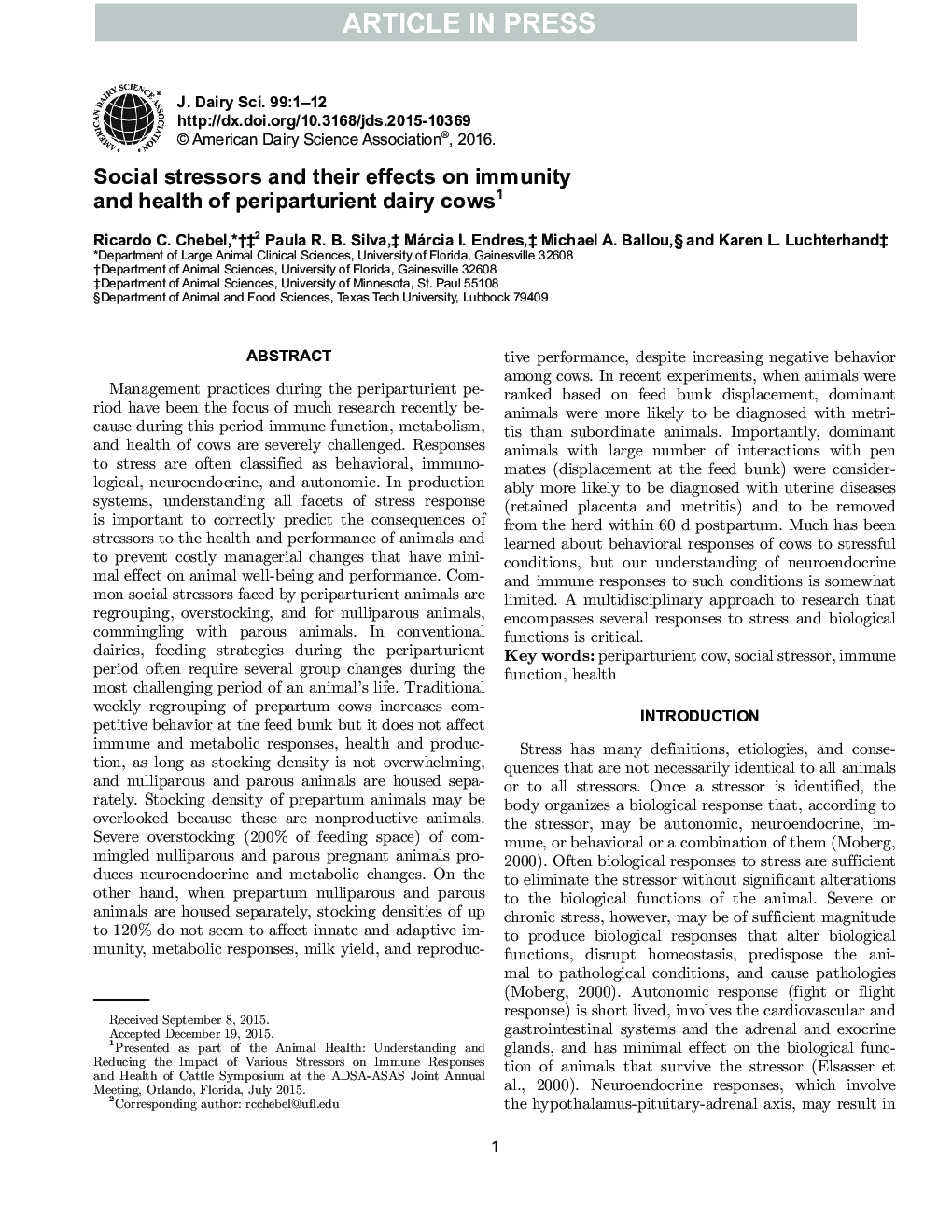| کد مقاله | کد نشریه | سال انتشار | مقاله انگلیسی | نسخه تمام متن |
|---|---|---|---|---|
| 10973160 | 1108010 | 2016 | 12 صفحه PDF | دانلود رایگان |
عنوان انگلیسی مقاله ISI
Social stressors and their effects on immunity and health of periparturient dairy cows1
ترجمه فارسی عنوان
فشارسنجهای اجتماعی و اثرات آنها بر ایمنی و سلامت گاوهای شیری که در دوران کودکی قرار دارند 1
دانلود مقاله + سفارش ترجمه
دانلود مقاله ISI انگلیسی
رایگان برای ایرانیان
کلمات کلیدی
گاو پرپراطوری فشار روحی اجتماعی، عملکرد ایمنی، سلامتی،
ترجمه چکیده
اخیرا تمرکز تحقیقات زیادی در زمینه رفتارهای مدیریتی در طول دوران پرایمر بوده است، زیرا در طی این دوره، عملکرد سیستم ایمنی، سوخت و ساز و سلامتی گاوها به شدت به چالش کشیده شده است. پاسخ به استرس اغلب به عنوان رفتاری، ایمونولوژیک، نوروآندوکرین و اتونومیک طبقه بندی می شود. در سیستم های تولید، درک تمام جنبه های پاسخ استرس به درستی پیش بینی عواقب ناشی از عوامل استرس زا برای سلامتی و عملکرد حیوانات و جلوگیری از تغییرات مدیریت هزینه ای است که حداقل بر سلامت و عملکرد حیوانات تاثیر می گذارد. استرسهای اجتماعی مشترک که با حیوانات حیوانات مواجه می شوند، گروه بندی، پرتاب و حیوانات زودگذر هستند که با حیوانات مضر مخلوط می شوند. در فرآورده های متعارف، استراتژی های تغذیه در طول دوره پرخطر، اغلب نیاز به تغییرات گروهی در طول دوره ی چالش برانگیز زندگی حیوانات دارند. بازنگری هفتگی سنتی گاوهای پیش از زایمان سبب رفتار رقابتی در بخش غذا می شود، اما در مورد واکنش های ایمنی و متابولیکی، سلامتی و تولید، تا زمانی که چگالی انبوهی غلبه نداشته باشد، حیوانات و حیوانات نابجا و عاری از حیوانات جداگانه قرار می گیرند. تراکم جوراب از حیوانات قبل از زایمان ممکن است نادیده گرفته شود زیرا این حیوانات غیر تولیدی هستند. فراوانی شدید (200٪ فضای تغذیه) از حیوانات باردار مبتلا به زودرس و مخلوط شده، تغییرات نوروآندوکرین و متابولیکی را ایجاد می کند. از سوی دیگر، به نظر می رسد که هنگامی که حیوانات زودرس و نابالغ قبل از زایمان جداگانه قرار می گیرند، تراکم ذخیره سازی تا 120٪ به نظر نمی رسد بر ایمنی ذاتی و سازگاری، پاسخ های متابولیکی، عملکرد شیر و عملکرد تولید مثل در مقایسه با رفتار رفتاری منفی در گاوها تاثیر بگذارد. در آزمایش های اخیر، زمانی که حیوانات بر اساس حرکت جابجایی در محل قرار گرفتند، حیوانات حاکم به احتمال بیشتری با متریت تشخیص داده می شدند تا حیوانات زیرزمینی. مهمتر از همه، حیوانات غالب با تعداد زیادی از تعاملات با همسران قلم (جابجایی در بخش غذا) احتمالا به احتمال زیاد با بیماری های رحم (جفت و متیل نگهدارنده) تشخیص داده می شود و از گاو در طی 60 روز پس از زایمان حذف می شود. در مورد پاسخ های رفتاری گاو ها به شرایط استرس زا فراوان شده است، اما درک ما از پاسخ های عصبی عضلانی و ایمنی به چنین شرایطی تا حدودی محدود است. رویکرد چند رشته ای به تحقیق که شامل چندین پاسخ به عملکرد استرس و بیولوژیکی می شود، حیاتی است.
موضوعات مرتبط
علوم زیستی و بیوفناوری
علوم کشاورزی و بیولوژیک
علوم دامی و جانورشناسی
چکیده انگلیسی
Management practices during the periparturient period have been the focus of much research recently because during this period immune function, metabolism, and health of cows are severely challenged. Responses to stress are often classified as behavioral, immunological, neuroendocrine, and autonomic. In production systems, understanding all facets of stress response is important to correctly predict the consequences of stressors to the health and performance of animals and to prevent costly managerial changes that have minimal effect on animal well-being and performance. Common social stressors faced by periparturient animals are regrouping, overstocking, and for nulliparous animals, commingling with parous animals. In conventional dairies, feeding strategies during the periparturient period often require several group changes during the most challenging period of an animal's life. Traditional weekly regrouping of prepartum cows increases competitive behavior at the feed bunk but it does not affect immune and metabolic responses, health and production, as long as stocking density is not overwhelming, and nulliparous and parous animals are housed separately. Stocking density of prepartum animals may be overlooked because these are nonproductive animals. Severe overstocking (200% of feeding space) of commingled nulliparous and parous pregnant animals produces neuroendocrine and metabolic changes. On the other hand, when prepartum nulliparous and parous animals are housed separately, stocking densities of up to 120% do not seem to affect innate and adaptive immunity, metabolic responses, milk yield, and reproductive performance, despite increasing negative behavior among cows. In recent experiments, when animals were ranked based on feed bunk displacement, dominant animals were more likely to be diagnosed with metritis than subordinate animals. Importantly, dominant animals with large number of interactions with pen mates (displacement at the feed bunk) were considerably more likely to be diagnosed with uterine diseases (retained placenta and metritis) and to be removed from the herd within 60Â d postpartum. Much has been learned about behavioral responses of cows to stressful conditions, but our understanding of neuroendocrine and immune responses to such conditions is somewhat limited. A multidisciplinary approach to research that encompasses several responses to stress and biological functions is critical.
ناشر
Database: Elsevier - ScienceDirect (ساینس دایرکت)
Journal: Journal of Dairy Science - Volume 99, Issue 4, April 2016, Pages 3217-3228
Journal: Journal of Dairy Science - Volume 99, Issue 4, April 2016, Pages 3217-3228
نویسندگان
Ricardo C. Chebel, Paula R.B. Silva, Márcia I. Endres, Michael A. Ballou, Karen L. Luchterhand,
